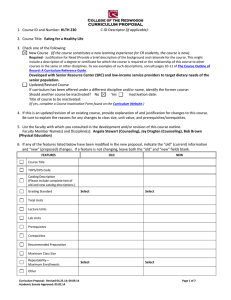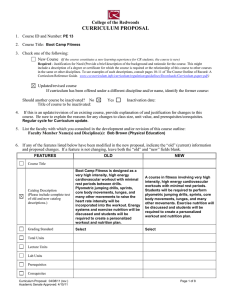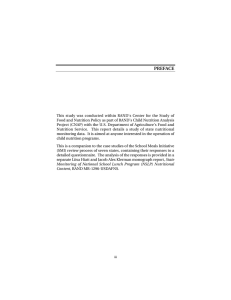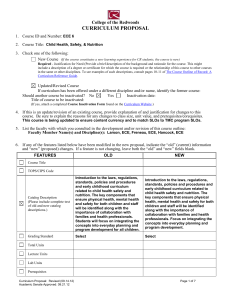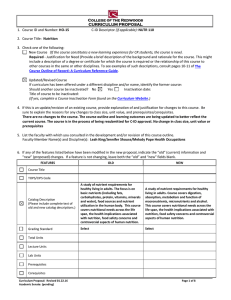CURRICULUM PROPOSAL College of the Redwoods 1. Course ID and Number:
advertisement
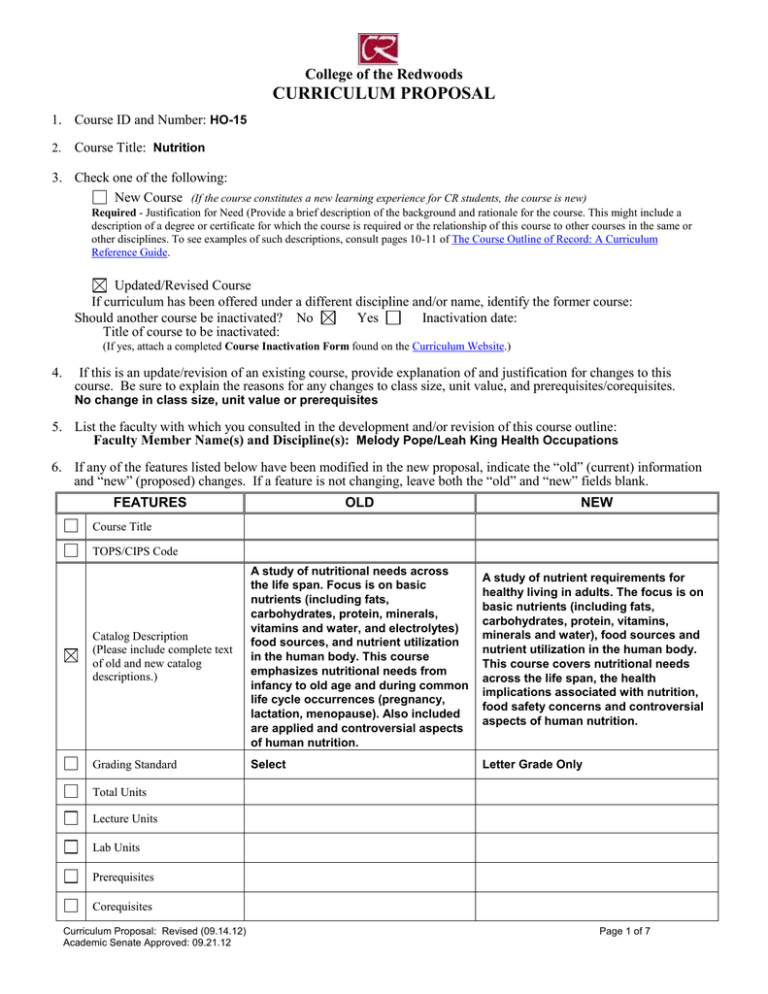
College of the Redwoods CURRICULUM PROPOSAL 1. Course ID and Number: HO-15 2. Course Title: Nutrition 3. Check one of the following: New Course (If the course constitutes a new learning experience for CR students, the course is new) Required - Justification for Need (Provide a brief description of the background and rationale for the course. This might include a description of a degree or certificate for which the course is required or the relationship of this course to other courses in the same or other disciplines. To see examples of such descriptions, consult pages 10-11 of The Course Outline of Record: A Curriculum Reference Guide. Updated/Revised Course If curriculum has been offered under a different discipline and/or name, identify the former course: Should another course be inactivated? No Yes Inactivation date: Title of course to be inactivated: (If yes, attach a completed Course Inactivation Form found on the Curriculum Website.) 4. If this is an update/revision of an existing course, provide explanation of and justification for changes to this course. Be sure to explain the reasons for any changes to class size, unit value, and prerequisites/corequisites. No change in class size, unit value or prerequisites 5. List the faculty with which you consulted in the development and/or revision of this course outline: Faculty Member Name(s) and Discipline(s): Melody Pope/Leah King Health Occupations 6. If any of the features listed below have been modified in the new proposal, indicate the “old” (current) information and “new” (proposed) changes. If a feature is not changing, leave both the “old” and “new” fields blank. FEATURES OLD NEW Course Title TOPS/CIPS Code Catalog Description (Please include complete text of old and new catalog descriptions.) A study of nutritional needs across the life span. Focus is on basic nutrients (including fats, carbohydrates, protein, minerals, vitamins and water, and electrolytes) food sources, and nutrient utilization in the human body. This course emphasizes nutritional needs from infancy to old age and during common life cycle occurrences (pregnancy, lactation, menopause). Also included are applied and controversial aspects of human nutrition. Grading Standard Select A study of nutrient requirements for healthy living in adults. The focus is on basic nutrients (including fats, carbohydrates, protein, vitamins, minerals and water), food sources and nutrient utilization in the human body. This course covers nutritional needs across the life span, the health implications associated with nutrition, food safety concerns and controversial aspects of human nutrition. Letter Grade Only Total Units Lecture Units Lab Units Prerequisites Corequisites Curriculum Proposal: Revised (09.14.12) Academic Senate Approved: 09.21.12 Page 1 of 7 Recommended Preparation Maximum Class Size Repeatability— Maximum Enrollments Select Select No repeats SLOs have been revised from six to three. Other 1. DATE: 4/1/2013 2. DIVISION: Health Occupations 3. COURSE ID AND NUMBER: HO-15 4. COURSE TITLE: Nutrition (Course title appears in Catalog and schedule of classes.) 5. SHORT TITLE: Nutrition (Short title appears on student transcripts and is limited to 30 characters, including spaces.) 6. LOCAL ID (TOPS): 130600 Taxonomy of Program Codes 7. NATIONAL ID (CIP): 19.0501 Classification of Instructional Program Codes 8. DISCIPLINE(S): Nutritional Science/Dietetics/Nursing Select from Minimum Qualifications for Faculty Course may fit more than one discipline; identify all that apply: 9. FIRST TERM NEW OR REVISED COURSE MAY BE OFFERED: Summer 2013 10. COURSE UNITS: TOTAL UNITS: LECTURE UNITS: 3 3 TOTAL HOURS: 54 LECTURE HOURS: 54 (1 Unit Lecture = 18 Hours; 1 Unit Lab = 54 Hours) LAB UNITS: LAB HOURS: 0 0 11. MAXIMUM CLASS SIZE: 40 12. WILL THIS COURSE HAVE AN INSTRUCTIONAL MATERIALS FEE? No Yes Fee: $ If yes, attach a completed Instructional Materials Fee Request Form found on the Curriculum Website. GRADING STANDARD Letter Grade Only Pass/No Pass Only Is this course a repeatable lab course? No Yes Grade-Pass/No Pass Option If yes, how many total enrollments? Select Is this course to be offered as part of the Honors Program? No Yes If yes, explain how honors sections of the course are different from standard sections. CATALOG DESCRIPTION -- The catalog description should clearly describe for students the scope of the course, its level, and what kinds of student goals the course is designed to fulfill. The catalog description should begin with a sentence fragment. A study of nutrient requirements for healthy living in adults. The focus is on basic nutrients (including fats, carbohydrates, protein, vitamins, minerals and water), food sources and nutrient utilization in the human body. This course covers nutritional needs from infancy to old age, the health implications associated with nutrition, food safety concerns and controversial aspects of human nutrition. Special Notes or Advisories (e.g. Field Trips Required, Prior Admission to Special Program Required, etc.): PREREQUISITE COURSE(S) No Yes Course(s): Rationale for Prerequisite: Describe representative skills without which the student would be highly unlikely to succeed . Curriculum Proposal: Revised (09.14.12) Academic Senate Approved: 09.21.12 Page 2 of 7 COREQUISITE COURSE(S) No Yes Course(s): Rationale for Corequisite: RECOMMENDED PREPARATION No Yes Course(s): English 350 and Math 376 Rationale for Recommended Preparation: Reading includes terminology and advanced concepts; Understanding of basic math calculations is required for the Diet Analysis COURSE LEARNING OUTCOMES –This section answers the question “what will students be able to do as a result of taking this course?” State some of the objectives in terms of specific, measurable student actions (e.g. discuss, identify, describe, analyze, construct, compare, compose, display, report, select, etc.). For a more complete list of outcome verbs please see Public Folders>Curriculum>Help Folder>SLO Language Chart. Each outcome should be numbered. 1. Identify nutrients in foods and explain how the human body utilizes these nutrients during various stages of the human life span. 2. Analyze and evaluate the adequacy of one’s own personal diet. 3. Differentiate fact from fallacy as it relates to nutritional controversies, including diet fads, the promotion of food products and the safety of foods. COURSE CONTENT–This section describes what the course is “about”-i.e. what it covers and what knowledge students will acquire All course content lists were copied from 2008 curriculum proposal, but some were organized as lists Concepts: What terms and ideas will students need to understand and be conversant with as they demonstrate course outcomes? Each concept should be numbered. 1. Dietary standards and guidelines. 2. Methods of meeting normal nutritional needs. 3. Nutrients essential for human health including carbohydrates, fats, proteins, vitamins and minerals. 4. Metabolic processes involved in nutrition. 5. Changes in nutritional needs across the life span, and at various stages of the life cycle. 6. Physiologic and cultural aspects of diet. 7. Causes and manifestations of various forms of malnutrition. Issues: What primary tensions or problems inherent in the subject matter of the course will students engage? Each issue should be numbered. 1. Impact of age, gender, activity, ethnicity, culture and class on food preferences and beliefs. 2. Controversial aspects of human nutrition including the significance of some trace elements in human nutrition, the safety of artificial sweeteners, the controversy over the allergenicity of cow's milk, the safety of genetic engineering of foods and other nutritionally based topics in current debate. 3. 1. 2. 3. Themes: What motifs, if any, are threaded throughout the course? Each theme should be numbered. Nutritional basis of health. Lifestyle/dietary choices which promote health or contribute to disease. Nutritional elements (fats, proteins, carbohydrates, vitamins, minerals) needed for human growth, development and maintenance. 4. Sound nutrition versus poor nutrition including obesity and malnutrition. Skills: What abilities must students have in order to demonstrate course outcomes? (E.g. write clearly, use a scientific calculator, read college-level texts, create a field notebook, safely use power tools, etc). Each skill should be numbered. 1. Analysis of nutritional elements contained in foods. 2. Self-reflection on nutritional intake patterns. 3. Memorization of the essential elements contained in various food groups. REPRESENTATIVE LEARNING ACTIVITIES –This section provides examples of things students may do to engage the course content (e.g., listening to lectures, participating in discussions and/or group activities, attending a field trip). These activities should relate directly to the Course Learning Outcomes. Each activity should be numbered. 1. Listening to lectures. 2. Viewing video presentations. Curriculum Proposal: Revised (09.14.12) Academic Senate Approved: 09.21.12 Page 3 of 7 3. Participating in class-wide discussions of key nutritional concepts and controversies. 4. Participating in small group activities and discussions. ASSESSMENT TASKS –This section describes assessments instructors may use to allow students opportunities to provide evidence of achieving the Course Learning Outcomes. Each assessment should be numbered. Representative Assessment Tasks (These are examples of assessments instructors could use.): Required Assessments for All Sections (These are assessments that are required of all instructors of all sections at all campuses/sites. Not all courses will have required assessments. Do not list here assessments that are listed as representative assessments above.): 1. Exams 2. Quizzes 3. Individual diet analysis project EXAMPLES OF APPROPRIATE TEXTS OR OTHER READINGS –This section lists example texts, not required texts. Author, Title, and Date Fields are required Nutrition Concepts and Controversies, 12th ed My Plate Edition edition in 2014 Author Sizer/Whitney Title switching to 13th Author Wadsworth Title Diet Analysis Plus 10.0 Author Title Date Author Title Date Date Date 2012 2013 Other Appropriate Readings: COURSE TYPES 1. Is the course part of a Chancellor’s Office approved CR Associate Degree? No Yes If yes, specify all program codes that apply. (Codes can be found in Outlook/Public Folders/All Public Folders/ Curriculum/Degree and Certificate Programs/choose appropriate catalog year): Required course for degree(s) DA.AS.2012,NURS.AS.2012.LVN,NURS.AS.2012.RN,NURS.AS.2012.PMED.LVN.RN Restricted elective for degree (s) Restricted electives are courses specifically listed (i.e. by name and number) as optional courses from which students may choose to complete a specific number of units required for an approved degree. 2. Is the course part of a Chancellor’s Office approved CR Certificate of Achievement? No Yes If yes, specify all program codes that apply. ( Codes can be found in Outlook/Public Folders/All Public Folders/ Curriculum/Degree and Certificate Programs/choose appropriate catalog year): Required course for certificate(s) DA.CA.2012,NURS.CA.2012.LVN,NURS.CA.2012.LVN.RN Restricted elective for certificate(s) Restricted electives are courses specifically listed (i.e. by name and number) as optional courses from which students may choose to complete a specific number of units required for an approved certificate. 3. Is the course Stand Alone? No Yes (If “No” is checked for BOTH #1 & #2 above, the course is stand alone.) 4. Basic Skills: NBS Not Basic Skills 5. Work Experience: NWE Not Coop Work Experience 6. Course eligible Career Technical Education funding (applies to vocational and tech-prep courses only): No 7. Course eligible Economic Workforce Development funding : No Yes (If TOPS code has an asterisk it is indicative that the course is vocational.) 8. Purpose: Y Credit Course Course Classification Status 9. Accounting Method: W Weekly Census Curriculum Proposal: Revised (09.14.12) Academic Senate Approved: 09.21.12 Yes Page 4 of 7 10. Disability Status: N Not a Special Class 11. Course SAM Priority Code: D: Possibly Occupational COURSE TRANSFERABILITY 1. Current Transferability Status: A Transferable to both UC and CSU 2. Course Prior to Transfer Level: Y – Not Applicable CURRENT TRANSFERABILITY STATUS (Check at least one box below): This course is currently transferable to: Neither CSU nor UC CSU as general elective credit CSU as a specific course equivalent (see below) If the course transfers as a specific course equivalent give course number(s)/ title(s) of one or more currently-active, equivalent lower division courses from CSU. 1. Course , Campus 2. Course , Campus UC as general elective credit UC as specific course equivalent If the course transfers as a specific course equivalent give course number(s)/ title(s) of one or more currently-active, equivalent lower division courses from UC. 1. Course , Campus 2. Course , Campus PROPOSED CSU TRANSFERABILITY (Check at least one of the boxes below): No Proposal Remove as General Education Propose as General Elective Credit Propose as a Specific Course Equivalent (see below) If specific course equivalent credit is proposed, give course number(s)/ title(s) of one or more currently-active, equivalent lower division courses from CSU. 1. Course , Campus 2. Course , Campus PROPOSED UC TRANSFERABILITY (Check one of the boxes below): No Proposal Remove as General Education Propose as General Elective Credit OR Specific Course Equivalent (fill in information below) If “General Elective Credit OR Specific Course Equivalent” box above is checked, give course number(s)/ title(s) of one or more currently-active, equivalent lower division courses from UC. 1. Course , Campus 2. Course , Campus CURRENTLY APPROVED GENERAL EDUCATION Check at least one box below): Not currently approved CR GE CR CR GE Category: CSU CSU GE Category: Area E IGETC IGETC Category: PROPOSED CR GENERAL EDUCATION (Check at least one box below): No Proposal Remove as General Education Review to maintain CR GE Status Curriculum Proposal: Revised (09.14.12) Academic Senate Approved: 09.21.12 ____ Approved as CR GE by Curriculum Committee: _____ _ ____ Not Approved (DATE) Page 5 of 7 New GE Proposal CR GE Outcomes: if CR GE, need to fill this in GE learning outcomes in Effective Communication, Critical Thinking, and Global Awareness must be addressed in all general education courses. Effective Communications: Explain how the proposed GE course fulfills at least one of the CR GE outcomes in this category. Critical Thinking: Explain how the proposed GE course fulfills at least one of the CR GE outcomes in this category. Global Awareness: Explain how the proposed GE course fulfills at least one of the CR GE outcomes in this category. GE Criteria for Breadth and Generality GE courses should be broad and general in scope. Typically such courses are introductory-- not advanced or specialized—and the content encompasses a broad spectrum of knowledge within a given field of study. Explain how the proposed GE course fulfills GE criteria for breadth and generality. CR GE Area Designation – if CR GE, need to fill this in Course Learning Outcomes and Course Content should provide evidence of appropriate GE Area Designation. Additional rationale for GE Area Designation (optional): Natural Science Social Science Humanities Language and Rationality Writing Oral Communications Analytical Thinking PROPOSED CSU GENERAL EDUCATION BREADTH (CSU GE) (Check at least one box below): No proposal A. Communications and Critical Thinking A1 – Oral Communication A2 – Written Communication A3 – Critical Thinking C. Arts, Literature, Philosophy, and Foreign Language C1 – Arts (Art, Dance, Music, Theater) C2 – Humanities (Literature, Philosophy, Foreign Language) E. Lifelong Understanding and Self-Development E1 – Lifelong Understanding E2 – Self-Development B. Science and Math B1 – Physical Science B2 – Life Science B3 – Laboratory Activity B4 – Mathematics/Quantitative Reasoning D. Social, Political, and Economic Institutions D0 – Sociology and Criminology D1 – Anthropology and Archeology D2 – Economics D3 – Ethnic Studies D5 – Geography D6 – History D7 – Interdisciplinary Social or Behavioral Science D8 – Political Science, Government and Legal Institutions D9 – Psychology Rationale for inclusion in this General Education category: Same as above Proposed Intersegmental General Education Transfer Curriculum (IGETC) (Check at least one box below): No proposal 1A – English Composition 1B – Critical Thinking-English Composition 1C – Oral Communication (CSU requirement only) 2A – Math 3A – Arts 3B – Humanities 4A – Anthropology and Archaeology 4B – Economics 4E – Geography Curriculum Proposal: 09.14.12 rev Academic Senate Approved: 09.21.12 Page 6 of 7 4F – History 4G – Interdisciplinary, Social & Behavioral Sciences 4H – Political Science, Government & Legal Institutions 4I – Psychology 4J – Sociology & Criminology 5A – Physical Science 5B – Biological Science 6A – Languages Other Than English Rationale for inclusion in this General Education category: Same as Above Submitted By: Christine Dobrowolski Division Chair/Director: Pat Girczyc Approved by Curriculum Committee: No Academic Senate Approval Date: 05.13.13 Curriculum Proposal: 09.14.12 rev Academic Senate Approved: 09.21.12 Tel. Ext. 4214 Review Date: 05/01/13 Date: 04/15/13 CURRICULUM COMMITTEE USE ONLY Yes Date: 05.10.13 Board of Trustees Approval Date: 06.04.13 Page 7 of 7

